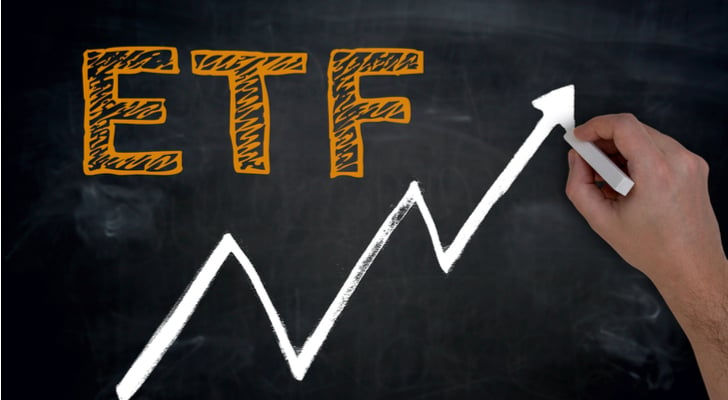The more I write about investments, the more I’m convinced the average investor should focus on must-buy ETFs rather than must-buy stocks for their investment portfolios.
The reality is that ETFs are less volatile than stocks. More importantly, the fear of missing out won’t be as significant because they generally don’t move as much in a single day of trading.
For example, looking at Finviz.com, I see 98 stocks (market capitalization greater than $2 billion) up more than 5% on the day out of 1,892 (5.2% of the total). Of the 2,166 ETFs, just 12 (0.6%) are up more than 5%. A similar differential applies to stocks and ETFs down more than 5%.
If you’re a long-term investor, a portfolio of core ETFs can be a much safer bet than a core portfolio of stocks.
For my list of top ETFs to buy for June 2023, I’ll recommend three core holdings from a list of the 100 largest ETFs by assets.
Here goes.
iShares Russell 1000 Growth ETF (IWF)

According to VettaFi.com, the iShares Russell 1000 Growth ETF (NYSEARCA:IWF) is the 14th-largest ETF of the top 100 with $68,5 billion in net assets.
As the ETF name implies, the ETF invests in growth-oriented mid and large-cap stocks. A passively managed ETF, it tracks the performance of the Russell 1000 Growth Index, a subset of the Russell 1000 Index. The growth index accounts for approximately 51% of the Russell 1000.
The index is looking for Russell 1000 companies “with higher price-to-book ratios, higher forecasted medium-term growth and higher sales per-share historical growth relative to all issuers whose securities are included in the Russell 1000 Index,” states IWF’s summary prospectus.
IWF has 509 holdings with a P/B ratio of 10.23x and an average market cap of $322.7 billion. The top three sectors by weighting are technology (43.65%), consumer discretionary (14.25%), and health care (11.10%). The top 10 holdings account for 48% of its net assets.
IWF covers both large-cap stocks and growth stocks in one pick. Morningstar.com gives it five stars.
Vanguard FTSE Developed Markets ETF (VEA)

The Vanguard FTSE Developed Markets ETF (NYSEARCA:VEA) is the 6th-largest ETF of the top 100 with $111.8 billion in net assets.
VEA invests in market caps of all sizes located outside the U.S. It tracks the performance of the FTSE Developed All Cap ex US Index, a market cap-weighted index with 3,990 companies. The ETF has 4,050 stocks with a median market cap of $36.8 billion, a P/B ratio of 1.6x, and an earnings growth rate of 7.7%.
The top three sectors by weighting are financial services (18.27%), industrials (16.60%), and health care (11.14%). The top three countries by weighting are Japan (20.00%), the United Kingdom (13.50%), and Canada (9.60%). It has holdings in 24 different countries. The top 10 holdings account for 11% of its net assets.
Although VEA is an all-cap ETF, large-cap stocks account for nearly 73% of its net assets. Morningstar.com gives it four stars. It charges just 0.05%, or $5 per $10,000 invested.
Vanguard Small-Cap Value ETF (VBR)

The Vanguard Small-Cap Value ETF (NYSEARCA:VBR) is the 64th-largest ETF of the top 100, with $23.8 billion in net assets. Morningstar gives it four stars.
As the ETF name implies, it invests in value-oriented small-cap stocks. It tracks the performance of the CRSP US Small Cap Value Index, a collection of U.S. companies between the bottom 2% and 15% of the investable market cap. It uses the following factors to evaluate the holdings in the index: book-to-price, forward earnings-to-price, historic earnings-to-price, dividend-to-price ratio, and sales-to-price ratio.
VBR has 848 holdings, four more than the index. The median market cap is $5.4 billion, with a P/B ratio of 1.6x and an earnings growth rate of 13.1%. The top three sectors by weighting are industrials (23.00%), financials (20.40%), and consumer discretionary (15.40%). The top 10 holdings account for 5% of its net assets.
The ETF charges a very reasonable 0.07% expense ratio. Its turnover rate is 13%, which means it turns the entire portfolio approximately once every 7.7 years.
On the date of publication, Will Ashworth did not have (either directly or indirectly) any positions in the securities mentioned in this article. The opinions expressed in this article are those of the writer, subject to the InvestorPlace.com Publishing Guidelines.
